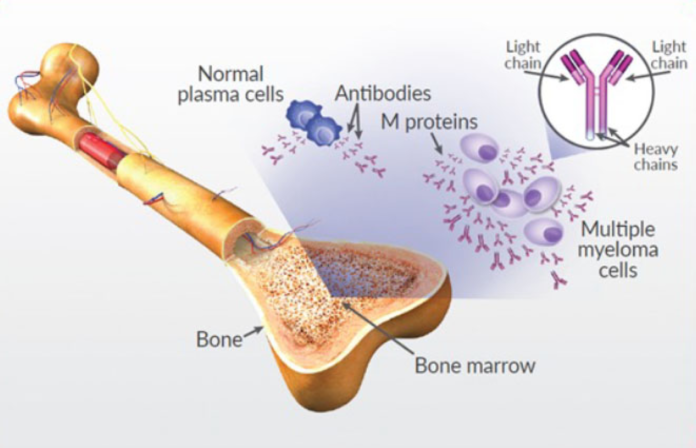BlueWeave Consulting, a leading strategic consulting and market research firm, in its recent study, estimated the global multiple myeloma market size at USD 21.46 billion in 2022. During the forecast period between 2023 and 2029, BlueWeave expects the global multiple myeloma market size to grow at a significant CAGR of 5.39% reaching a value of USD 29.4 billion by 2029. Major growth drivers for the global multiple myeloma market include the increasing adoption of microRNA therapies. These innovative treatment modalities harness the potential of microRNAs to regulate gene expression and oversee diverse cellular processes. The evolution of precisely targeted microRNA therapies holds promise for delivering more individualized and accurate treatments for multiple myeloma. Furthermore, the ascent of advanced biomedicine platforms plays a pivotal role in propelling the expansion of the multiple myeloma market. These multifaceted platforms encompass a wide spectrum of technologies and methodologies that facilitate the understanding of the molecular foundations of the disease, the identification of novel therapeutic targets, and the development of more effective treatment approaches. By harnessing the capabilities of these sophisticated platforms, researchers and healthcare professionals can delve deeper into the intricacies of multiple myeloma, thereby advancing the creation of groundbreaking therapeutic interventions. However, high treatment costs and stringent regulatory requirements are anticipated to restrain the overall market growth during the forecast period.
Global Multiple Myeloma Market – Overview
The global multiple myeloma market refers to the collective economic and commercial landscape associated with the diagnosis, treatment, and management of multiple myeloma, a type of cancer that affects plasma cells in the bone marrow. The market encompasses various pharmaceutical products, medical devices, diagnostic tools, research initiatives, and healthcare services related to multiple myeloma. It involves the production, distribution, and consumption of drugs, therapies, and technologies aimed at preventing, controlling, or curing multiple myeloma, as well as efforts to enhance patient care, improve outcomes, and advance scientific understanding of the disease. The global multiple myeloma market is influenced by medical advancements, regulatory policies, research and development activities, and the demand for innovative treatment approaches in the global healthcare industry.
Sample Request @ https://www.blueweaveconsulting.com/report/multiple-myeloma-market/report-sample
Impact of COVID-19 on Global Multiple Myeloma Market
COVID-19 pandemic adversely affected the global multiple myeloma market. The crisis disrupted supply chains, delayed clinical trials, and redirected healthcare resources toward managing the pandemic. Multiple myeloma patients faced challenges in accessing treatments and medical care due to overwhelmed healthcare systems and safety concerns. Telemedicine gained prominence for consultations, but in-person treatments and clinical assessments were often delayed. Additionally, financial strains on healthcare systems affected research funding and hindered the development of new therapies. Despite these setbacks, the pandemic accelerated digital health adoption and emphasized the importance of resilient healthcare systems. The Global Multiple Myeloma Market is adapting to these challenges, but its growth trajectory was undoubtedly impacted by the pandemic.
Global Multiple Myeloma Market – By Treatment
Based on treatment, the global multiple myeloma market is divided into Chemotherapy, Targeted Therapy, Immunomodulatory Drugs, Steroids, Bone-modifying Drugs, Immunotherapy, Bone Marrow/Stem Cell Transplantation, Radiation Therapy, and Surgery segments. The immunomodulatory drugs segment holds the highest share in the global multiple myeloma market by treatment. The prominence of immunomodulators in the market is attributed to various factors, including the increasing prevalence of multiple myeloma and the rising demand for these drugs. Immunomodulators play a crucial role in modifying or delaying the progression of autoimmune, inflammatory, and cancerous conditions, with notable drugs, such as Thalomid, Revlimid, and pomalyst, being used for multiple myeloma treatment. The growing incidence of multiple myeloma is a primary driver, with lenalidomide, an immunomodulatory drug, demonstrating improved outcomes in studies, enhancing progression-free survival, response depth, and overall survival rates. This is expected to boost its adoption among patients and stimulate market growth. Also, increased research and development efforts and a rising number of drug approvals further contribute to market expansion.
Competitive Landscape
Major players operating in the global multiple myeloma market include Sanofi, Pfizer Inc., GlaxoSmithKline plc, Novartis AG, Bayer AG, Eli Lilly and Company, Merck & Co., Inc., AstraZeneca, Bristol-Myers Squibb Company, AbbVie Inc., Teva Pharmaceutical Industries Ltd, ONO Pharmaceutical Co., Ltd, Takeda Pharmaceutical Company Ltd, and Roche Group. To further enhance their market share, these companies employ various strategies, including mergers and acquisitions, partnerships, joint ventures, license agreements, and new product launches.
Contact Us:
BlueWeave Consulting & Research Pvt. Ltd
+1 866 658 6826 | +1 425 320 4776 | +44 1865 60 0662














